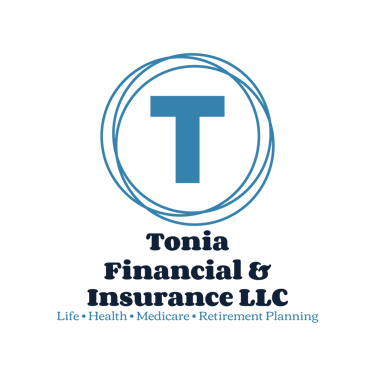How to Use Your Tax Refund to Build Wealth
Tax season is here, and for many, that means a refund is on the way. It’s tempting to see this money as a windfall—a chance to splurge on a vacation, upgrade your wardrobe, or indulge in a luxury purchase. While there’s nothing wrong with treating yourself, your tax refund can be a powerful tool to build long-term financial security. Instead of letting your refund slip through your fingers, why not use it to move closer to financial freedom? Here’s how to put that money to work in ways that will benefit you far beyond tax season.
TAX TIPS
Tonia Perry
2/9/20254 min read


Tax season is here, and for many, that means a refund is on the way. It’s tempting to see this money as a windfall—a chance to splurge on a vacation, upgrade your wardrobe, or indulge in a luxury purchase. While there’s nothing wrong with treating yourself, your tax refund can be a powerful tool to build long-term financial security.
Instead of letting your refund slip through your fingers, why not use it to move closer to financial freedom? Here’s how to put that money to work in ways that will benefit you far beyond tax season.
Step 1: Shift Your Mindset—Treat Your Refund as a Tool, Not a Temporary Bonus
For many people, a tax refund is just the government returning money that was withheld from their paycheck. But if you qualify for the Earned Income Tax Credit (EITC), your refund truly is extra money designed to provide financial relief. While this can feel like a well-deserved windfall, it’s important to use it wisely so it benefits you long after tax season.
Instead of seeing your refund as a temporary boost to your spending power, think of it as a tool to improve your financial situation. This could mean catching up on bills, reducing debt, saving for the future, or making an investment in yourself. You worked hard for this money—make sure it works hard for you in return.
Before making any decisions, take a step back and ask yourself:
What’s my biggest financial challenge right now? (Debt, lack of savings, job uncertainty?)
What financial goal would make the biggest difference in my life? (A safety net, getting ahead on rent, saving for a better opportunity?)
How can I use this refund to create lasting financial security instead of just short-term relief?
By treating your refund as a stepping stone toward financial stability rather than quick spending money, you set yourself up for long-term success.
Step 2: Build or Boost Your Emergency Fund
Life is unpredictable, and having a financial cushion can make all the difference when unexpected expenses arise. Experts recommend having at least three to six months' worth of living expenses in an emergency fund. If you don’t have one yet, your tax refund is a great way to start.
Even if you already have some savings, adding to your emergency fund can give you greater security. Consider keeping your emergency fund in a high-yield savings account so it can grow while remaining easily accessible when needed.
Step 3: Pay Down High-Interest Debt
If you have credit card debt, personal loans, or other high-interest obligations, using your tax refund to pay them down can save you hundreds or even thousands of dollars in interest over time.
Start with the debts that carry the highest interest rates—these cost you the most money in the long run. This strategy, often called the avalanche method, helps you eliminate expensive debt quickly.
Alternatively, if you prefer small wins to keep you motivated, the snowball method suggests paying off your smallest debt first, then rolling those payments into the next smallest debt. Both strategies work—the key is to pick one and stick with it.
Step 4: Invest in Your Future
Your tax refund can be a great way to start investing or increase your contributions if you’re already on that path.
Retirement Savings: If your employer offers a 401(k) with matching contributions, consider using your refund to increase your contributions. If you don’t have a 401(k), you can contribute to an IRA (either traditional or Roth) to build long-term wealth.
Brokerage Accounts: Investing in a taxable brokerage account allows you to grow your wealth over time through stocks, ETFs, or index funds. If you’re new to investing, start with low-cost index funds that track the overall market.
529 College Savings Plan: If you have children, consider putting part of your refund into a 529 plan to save for their education. These accounts offer tax advantages and can ease the burden of college expenses in the future.
Step 5: Start or Grow a Side Hustle
If you’ve been thinking about launching a side business, your tax refund can provide the startup capital you need. Whether you want to sell handmade products, start freelancing, or invest in an online business, a small financial boost can help you get started.
Use your refund to:
Purchase equipment or tools for your business
Build a simple website and set up marketing materials
Take a course to develop your skills
Cover initial costs like software subscriptions or business licenses
A side hustle not only brings in extra income but also gives you more control over your financial future.
Step 6: Make Home Improvements That Save You Money
Spending your refund on home upgrades can be a smart way to invest in your property while cutting long-term costs. Energy-efficient improvements, for example, can lower your monthly bills while increasing your home’s value.
Consider upgrades like:
Insulating your home to reduce heating and cooling costs
Installing energy-efficient windows
Upgrading to LED lighting
Purchasing energy-efficient appliances
These improvements not only save you money but also make your home more comfortable and valuable.
Step 7: Invest in Yourself
Sometimes, the best investment you can make is in your own growth and knowledge. Your tax refund can help you:
Enroll in a certification program to boost your career
Take a course to learn a new skill
Buy books or online courses on personal finance, investing, or entrepreneurship
Building your skills and knowledge can open doors to new opportunities and increase your earning potential.
Step 8: Give Your Future Self a Head Start
If you’re financially stable and have already covered the basics, consider using your tax refund to prepay future expenses. This could mean making an extra mortgage payment, prepaying insurance premiums, or even setting aside funds for holiday shopping later in the year.
By thinking ahead, you reduce financial stress and free up your regular income for other goals.
Step 9: Give Back
If you’re in a good place financially, consider using part of your refund to give back to your community. Donating to a cause you care about not only helps others but can also provide tax benefits next year.
You can:
Donate to a nonprofit organization
Support a scholarship fund
Contribute to a local food bank or charity
Giving back is a rewarding way to use your money and make a difference.
Final Thoughts: Be Intentional With Your Refund
A tax refund can be a powerful tool for financial growth if used wisely. While it’s okay to set aside a small portion for fun, being intentional with the bulk of your refund can set you up for a more secure and prosperous future.
Before spending your refund, take a moment to reflect on your financial priorities. A little planning now can make a huge difference in your journey to financial freedom.

EMAIL: Strive.tonia@gmail.com
PHONE:(216)800-7303
© 2025. All rights reserved.
We do not offer every plan available in your area. Currently, we represent 9 organizations which offer 80 products in your area. Please contact Medicare.gov, 1-800-MEDICARE, or your local State Health Insurance Assistance Program (SHIP) to get information on all of your options. This is a proprietary website and is not associated, endorsed or authorized by the Social Security Administration, the Department of Health and Human Services or the Center for Medicare and Medicaid Services. This site contains decision-support content and information about Medicare, services related to Medicare and services for people with Medicare. If you would like to find more information about the Medicare program please visit the Official U.S. Government Site for People with Medicare located at http://www.medicare.gov
Independent Insurance Agent | Final Expense Insurance Ohio | Medicare Advantage Plans Cleveland | Life Insurance for Children | Medigap Plans PA | Insurance Advisor for Seniors | Community Insurance Help
